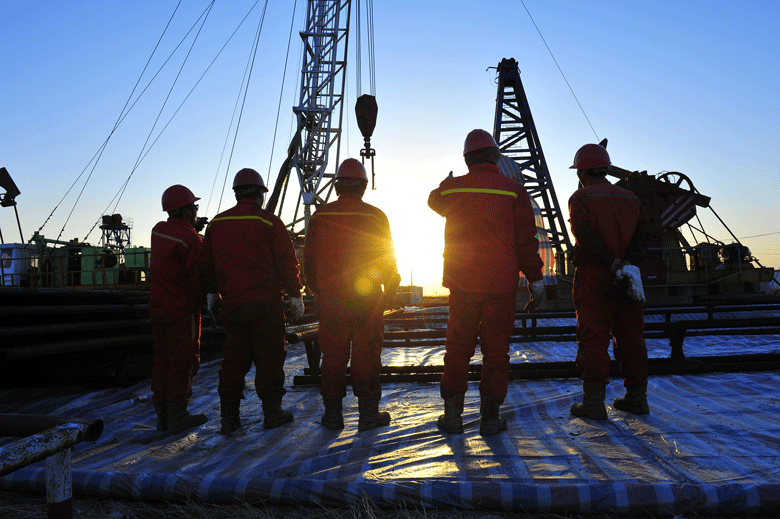

The nature of the product in the oil and gas sector makes the industry perceivably more dangerous. And yet, the likelihood of dangerous incidents in the construction industry is far bigger than on oil and gas projects. The reason behind this is a fundamental difference in approach to safety between the two sectors.
“Most oil and gas projects are based in isolated locations, ie, offshore or in deserts, and when safety systems fail, they tend to be major — for instance, Piper Alpha,” says one oil and gas contractor.
Additionally, the oil and gas industry has better enforced health and safety laws as a result of previous disasters and employs highly qualified safety managers to oversee these laws. Construction industries in the region have been less effective at standardising and enforcing safety regulations. Falls from heights and objects falling from height onto passersby below are two of the biggest forms of accidents on construction sites, and both are easily preventable using harnesses and safety railings.
Lack of transparent data makes it difficult to equate the two industries’ accident records side by side. Experts, however, agree that training is one of the biggest factors in favour of oil companies. The induction process for workers is stringent, often running for a number of weeks, ensuring they are well versed in preventing accidents.
 “Companies like Adnoc do not let a worker even set foot on site unless he is familiarised with all aspects of the safety training process,” says a source. “The cost of major industrial oil-related incidents is usually millions of dollars, and the consequent business interruptions are around four times more expensive again, not counting litigation, investigation and regulatory penalties.”
“Companies like Adnoc do not let a worker even set foot on site unless he is familiarised with all aspects of the safety training process,” says a source. “The cost of major industrial oil-related incidents is usually millions of dollars, and the consequent business interruptions are around four times more expensive again, not counting litigation, investigation and regulatory penalties.”
Severity and probability are key factors in risk assessments. “While the severity of accidents in oil and gas is higher, the probability is lower because everything is much more controlled,” says one contractor. “On the other hand, severity is a variable in construction, but probability is instantly higher, merely because of the lack of awareness.”
Reasons for negligence
Construction companies often skimp on the training process due to the short turnaround times on projects. “If a project is due to be delivered in a matter of months, assigning a quarter of it for training is simply counterproductive to a contractor,” says a source.
Another obstacle for safety in construction occurs in the form of diverse migrant workers, who speak different languages and have varied cultural approaches to safety.
“Although there are many published health and safety regulations, primarily from the UK and US, these are not as readily used. The construction workforce tends to be unqualified or uneducated personnel, with in many cases language differences. The safety information given to the workforce is nor as detailed or enforced by better-qualified supervisors,” says one source.
Operational distinctions between various construction companies also dictates their investments – and interests – in safety. Large-scale companies such as Emaar follow government regulations, often because their projects are under global scrutiny. Smaller-scale companies, however, tend to operate without set safety standards because of the additional costs it entails, and also because they can just “get away with it”. Firmer implementation of laws is the answer to this.
 Construction is catching up with the safety standards of oil and gas projects. Government regulations have toughened over the years, prioritising worker safety.
Construction is catching up with the safety standards of oil and gas projects. Government regulations have toughened over the years, prioritising worker safety.
Technology is a common ground for both industries. Sensors that detect chemical leaks and potential hazards, virtual reality gear and drones are just some of the trends that have found acceptance on both sides.
What construction companies are increasingly coming to understand is that mere adoption of practices will not suffice. They need to be followed through to ensure a zero-accident environment as per regulatory framework. And while construction does have a long way to go, it is getting there gradually.

This article is extracted from a report produced by MEED and Mashreq titled Transforming Construction: Lessons from Oil & Gas. Click here to download the report
You might also like...

TotalEnergies to acquire remaining 50% SapuraOMV stake
26 April 2024

Hyundai E&C breaks ground on Jafurah gas project
26 April 2024

Abu Dhabi signs air taxi deals
26 April 2024

Spanish developer to invest in Saudi housing
26 April 2024
A MEED Subscription...
Subscribe or upgrade your current MEED.com package to support your strategic planning with the MENA region’s best source of business information. Proceed to our online shop below to find out more about the features in each package.




